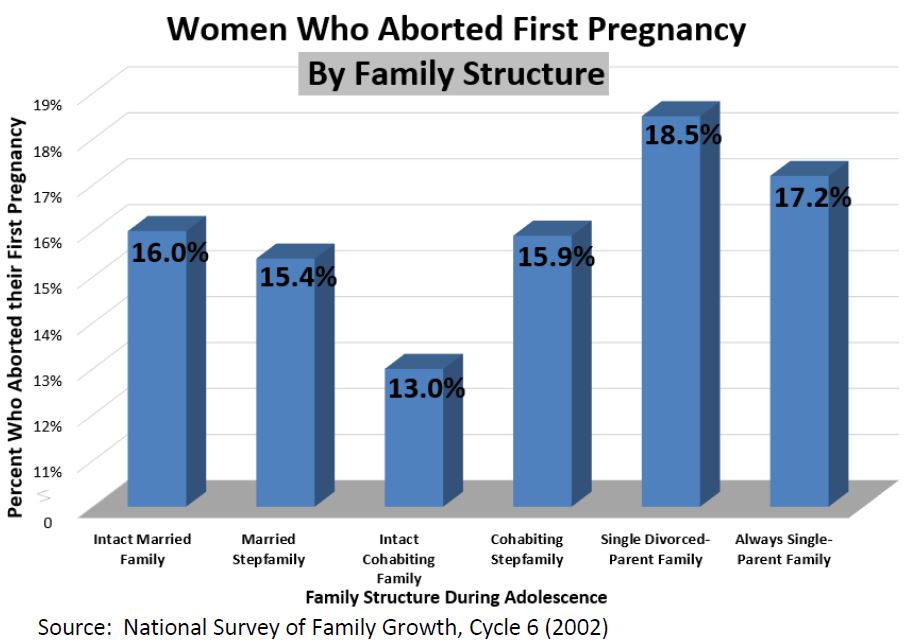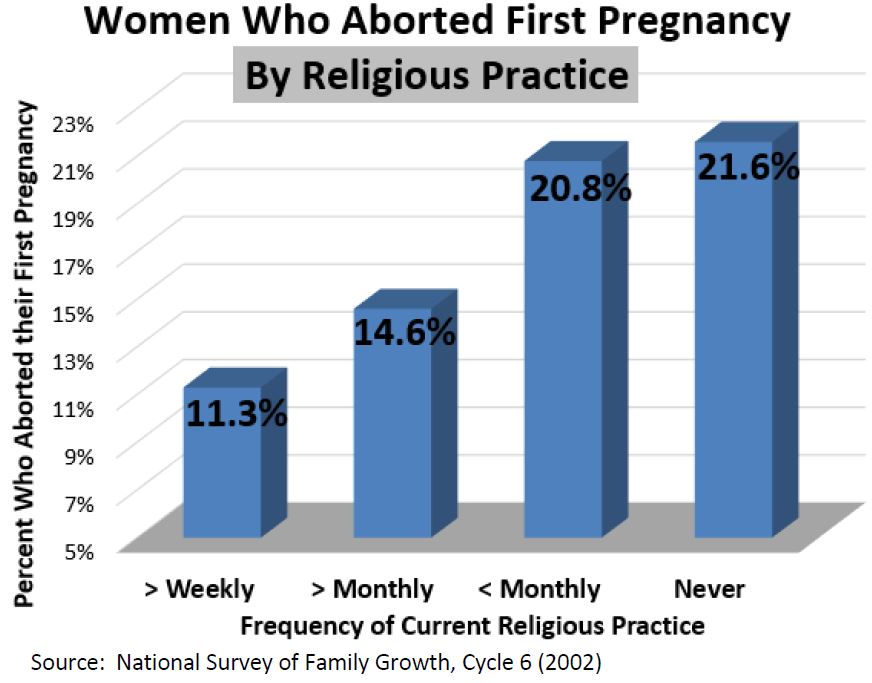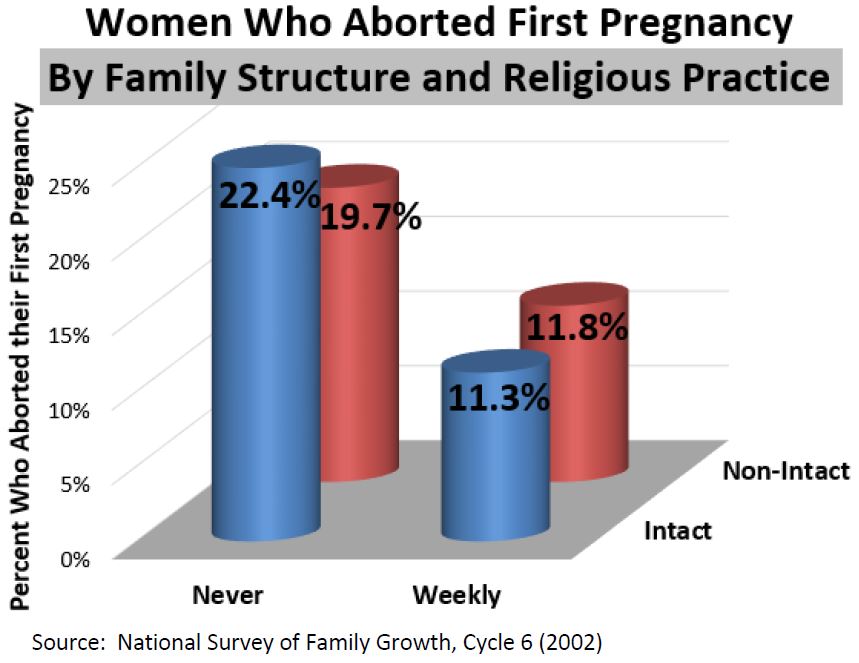Click Here to download “Women Who Aborted First Pregnancy by Family Structure and Religious Practice”
Women Who Aborted First Pregnancy by Family Structure and Religious Practice
Family Structure: According to the National Survey of Family Growth Cycle 6, 13 percent of women who grew up in intact cohabiting families aborted their first pregnancy, followed by women who grew up in married stepfamilies (15.4 percent), those from cohabiting stepfamilies (15.9 percent), intact married families (16 percent), always single parent families (17.2 percent), and single divorced parent families (18.5 percent). It is to be noted that the typical pattern of the intact married family being the strongest is broken here.
[1]  Religious Practice:
Religious Practice: According to the National Survey of Family Growth, 11.3 percent of women who worshiped at least weekly aborted their first pregnancy, followed by those who attended religious services between one and three times a month (14.6 percent), those who attended religious services less than once a month (20.8 percent), and those who never attended religious services (21.6 percent).
 Family Structure and Religious Practice Combined:
Family Structure and Religious Practice Combined: Women who worshiped at least weekly and grew up in intact married families were the least likely to abort their first baby. According to the National Survey of Family Growth, 11.3 percent of women who grew up in intact married families and worshiped at least weekly at the time of the survey aborted their first pregnancy, followed by women who grew up in other family structures and worshiped at least weekly (11.8 percent), those who grew up in other family structures and never worshiped (19.7 percent), and those who grew up in intact married families and never worshiped (22.4 percent).
 Related Insights from Other Studies:
Related Insights from Other Studies: Several other studies corroborate the direction of these findings. Stanley Henshaw and Kathryn Kost of the Alan Guttmacher Institute reported that “being a born-again or Evangelical Christian” reduced the risk of an “unintended pregnancy leading to abortion.”
[2]
Lisa Pearce of the University of North Carolina at Chapel Hill and Arland Thornton of the University of Michigan found that the more frequently eighteen-year-olds attend religious services, the more antiabortion they are.
[3]
No other significant studies investigated a correlation between abortion and structure of family of origin.
[1] These charts draw on data collected by the National Survey of Family Growth, Cycle 6 (2002). The sample consists of women between the ages of 14 and 44 and numbers 7,643.
[2] Stanley K. Henshaw and Kathryn Kost, “Abortion Patients in 1994-1995: Characteristics and Contraceptive Use,”
Family Planning Perspectives 28 (1996): 140-47, 158.
[3] Lisa Pearce and Arland Thornton, “Religious Identity and Family Ideologies in the Transition to Adulthood,”
Journal of Marriage and Family 69 (2007): 1227-43.
]]>
 Religious Practice: According to the National Survey of Family Growth, 11.3 percent of women who worshiped at least weekly aborted their first pregnancy, followed by those who attended religious services between one and three times a month (14.6 percent), those who attended religious services less than once a month (20.8 percent), and those who never attended religious services (21.6 percent).
Religious Practice: According to the National Survey of Family Growth, 11.3 percent of women who worshiped at least weekly aborted their first pregnancy, followed by those who attended religious services between one and three times a month (14.6 percent), those who attended religious services less than once a month (20.8 percent), and those who never attended religious services (21.6 percent).
 Family Structure and Religious Practice Combined: Women who worshiped at least weekly and grew up in intact married families were the least likely to abort their first baby. According to the National Survey of Family Growth, 11.3 percent of women who grew up in intact married families and worshiped at least weekly at the time of the survey aborted their first pregnancy, followed by women who grew up in other family structures and worshiped at least weekly (11.8 percent), those who grew up in other family structures and never worshiped (19.7 percent), and those who grew up in intact married families and never worshiped (22.4 percent).
Family Structure and Religious Practice Combined: Women who worshiped at least weekly and grew up in intact married families were the least likely to abort their first baby. According to the National Survey of Family Growth, 11.3 percent of women who grew up in intact married families and worshiped at least weekly at the time of the survey aborted their first pregnancy, followed by women who grew up in other family structures and worshiped at least weekly (11.8 percent), those who grew up in other family structures and never worshiped (19.7 percent), and those who grew up in intact married families and never worshiped (22.4 percent).
 Related Insights from Other Studies: Several other studies corroborate the direction of these findings. Stanley Henshaw and Kathryn Kost of the Alan Guttmacher Institute reported that “being a born-again or Evangelical Christian” reduced the risk of an “unintended pregnancy leading to abortion.”[2]
Lisa Pearce of the University of North Carolina at Chapel Hill and Arland Thornton of the University of Michigan found that the more frequently eighteen-year-olds attend religious services, the more antiabortion they are.[3]
No other significant studies investigated a correlation between abortion and structure of family of origin.
[1] These charts draw on data collected by the National Survey of Family Growth, Cycle 6 (2002). The sample consists of women between the ages of 14 and 44 and numbers 7,643.
[2] Stanley K. Henshaw and Kathryn Kost, “Abortion Patients in 1994-1995: Characteristics and Contraceptive Use,” Family Planning Perspectives 28 (1996): 140-47, 158.
[3] Lisa Pearce and Arland Thornton, “Religious Identity and Family Ideologies in the Transition to Adulthood,” Journal of Marriage and Family 69 (2007): 1227-43.
]]>
Related Insights from Other Studies: Several other studies corroborate the direction of these findings. Stanley Henshaw and Kathryn Kost of the Alan Guttmacher Institute reported that “being a born-again or Evangelical Christian” reduced the risk of an “unintended pregnancy leading to abortion.”[2]
Lisa Pearce of the University of North Carolina at Chapel Hill and Arland Thornton of the University of Michigan found that the more frequently eighteen-year-olds attend religious services, the more antiabortion they are.[3]
No other significant studies investigated a correlation between abortion and structure of family of origin.
[1] These charts draw on data collected by the National Survey of Family Growth, Cycle 6 (2002). The sample consists of women between the ages of 14 and 44 and numbers 7,643.
[2] Stanley K. Henshaw and Kathryn Kost, “Abortion Patients in 1994-1995: Characteristics and Contraceptive Use,” Family Planning Perspectives 28 (1996): 140-47, 158.
[3] Lisa Pearce and Arland Thornton, “Religious Identity and Family Ideologies in the Transition to Adulthood,” Journal of Marriage and Family 69 (2007): 1227-43.
]]>
